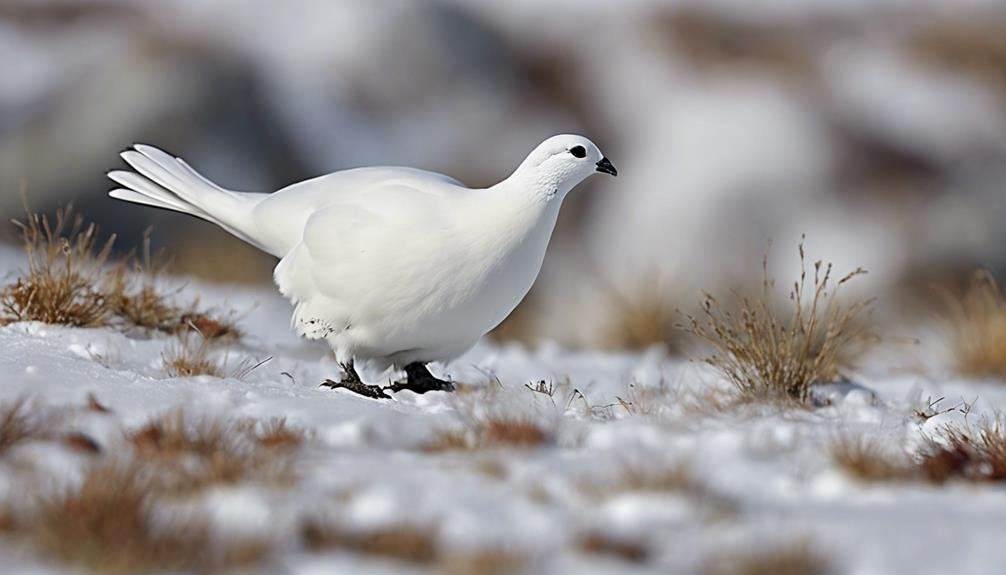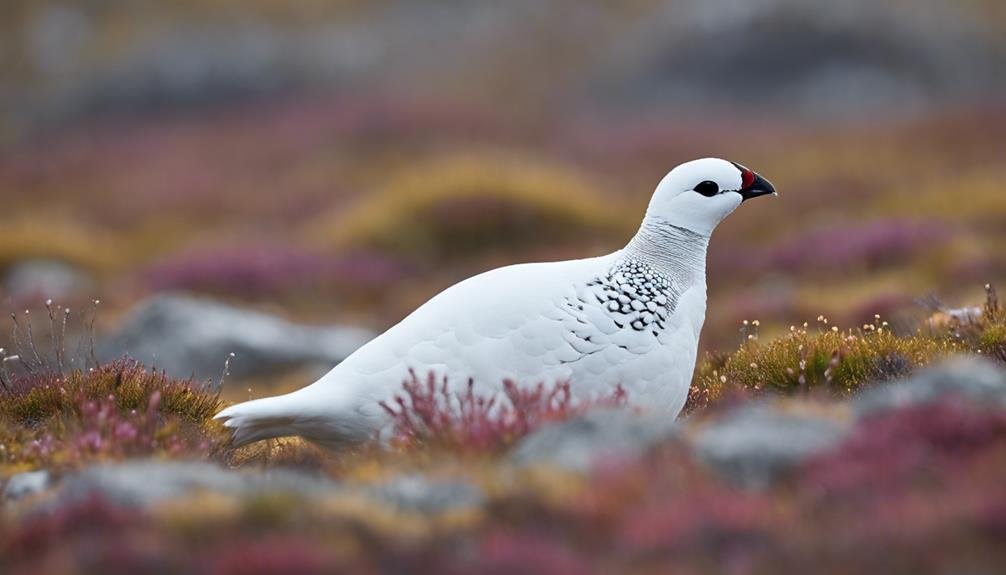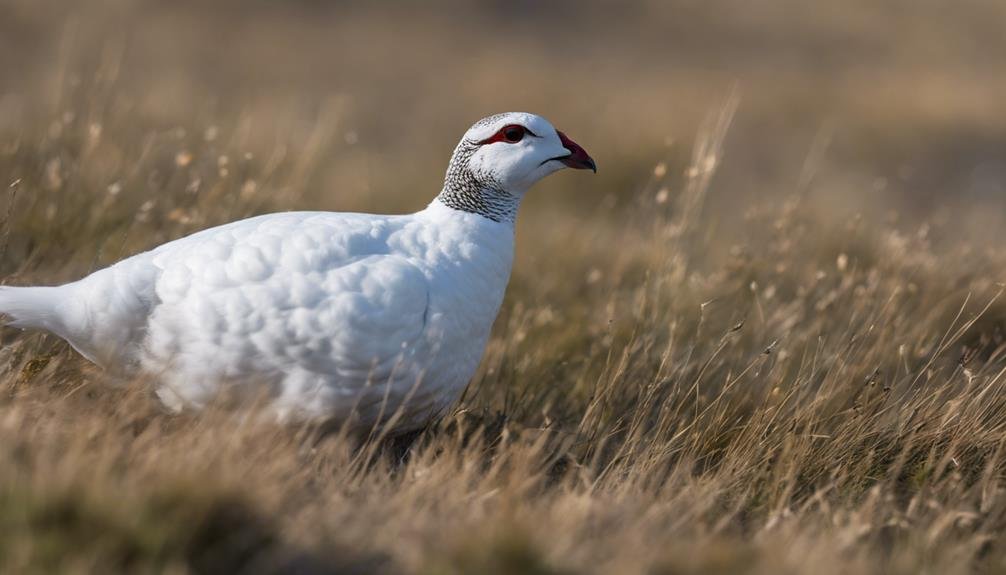Why are ptarmigans considered to have a complex life cycle?
At first glance, one might think the life cycle of a ptarmigan is straightforward. However, a closer look reveals an intricate balance of behaviors and adaptations that ensure their survival in challenging environments.
The ptarmigan is renowned for its remarkable ability to thrive across varying seasons, exhibiting a fascinating array of behavioral adaptations and facing numerous environmental challenges. These birds adeptly switch their diet from insects and larvae to seeds and berries as they grow, showcasing their flexibility in navigating their ecosystem.
The complexity of their survival tactics extends to their migration patterns, predator avoidance strategies, and sophisticated mating rituals, highlighting a nuanced social structure. This intricate web of behaviors not only underpins the survival of the ptarmigan but also plays a crucial role in maintaining ecological balance and informing conservation strategies. Understanding the ptarmigan’s life cycle offers valuable insights into the interconnectedness of species and the importance of preserving natural habitats.
Key Takeaways
Ptarmigans exhibit a range of distinctive adaptations and behaviors, illustrating their important role in their ecosystems. These birds are not only interesting for their biological characteristics but also for demonstrating the complex relationships between organisms and their surroundings.
The impact of climate change, through changes in habitat and food sources, highlights the susceptibility of ptarmigans to environmental changes. It is critical to implement conservation efforts focused on these challenges to ensure their survival.
Researching their diet, migration, and reproduction provides insights into ecological balance and the effects of environmental changes. Therefore, safeguarding ptarmigans is a key action in maintaining biodiversity and ecosystem health.
Key Takeaways:
- Ptarmigans possess unique adaptations that underscore their ecological importance.
- Climate change impacts such as habitat and food source alterations pose threats to ptarmigans.
- Conservation efforts are necessary to address the challenges faced by ptarmigans due to environmental changes.
- Studying ptarmigan behavior offers insights into ecological balance and the importance of biodiversity.
Scientific Classification
Exploring the Rock Ptarmigan: A Unique Avian Species
The Intriguing World of the Rock Ptarmigan
In the study of birds, the Rock Ptarmigan (Lagopus muta) captures attention with its remarkable traits and place in the animal kingdom. Known as Aqiggiq in Inuktitut, this bird is a fascinating example of adaptation and survival. Its diet and changing plumages are key aspects that make it a subject of interest among ornithologists.
Adaptability Through Diet
One of the most adaptable aspects of the Rock Ptarmigan is its omnivorous diet. This bird’s ability to consume both plant materials and invertebrates allows it to thrive in diverse habitats. This dietary adaptability is vital for its survival and plays a significant role in its reproductive success across different ecosystems.
Seasonal Camouflage: A Survival Strategy
What truly sets the Rock Ptarmigan apart is its unique approach to camouflage. The bird undergoes three distinct plumage changes throughout the year, each perfectly blending with the seasonal environment. This adaptive strategy isn’t just about survival; it’s a testament to the bird’s evolutionary ingenuity, enabling it to evade predators and thrive in its natural habitat.
The Significance of the Rock Ptarmigan in Avian Biodiversity
The Rock Ptarmigan’s unique adaptations, from its versatile diet to its seasonal plumages, underscore its place within Lagopus muta. These characteristics aren’t just fascinating on their own; they offer insights into avian evolution and the ecological niches that birds occupy. The Rock Ptarmigan exemplifies the incredible adaptability of avian species, contributing valuable knowledge to the field of ornithology.
Habitat

Ptarmigan Habitats Throughout the Seasons
Ptarmigans are remarkable birds known for their ability to thrive in varying environments throughout the year. Their habitat preferences change with the seasons, reflecting a sophisticated adaptation strategy to the world around them.
Summer: A Time for Exploration and Abundance
During the warmer months, ptarmigans are drawn to tundra landscapes, vast expanses where the ground beneath is permanently frozen. Here, they enjoy the openness and the sparse vegetation that springs up during the short summer. Moving slightly up, the alpine tree line presents another favored summer habitat. This unique zone, where trees cease to grow because of the cold, offers a different set of resources for the birds. Additionally, mountain slopes provide steep terrains rich in diverse vegetation, allowing ptarmigans to forage and live in areas that many other species might find inhospitable.
Winter: Seeking Refuge and Warmth
As the climate shifts, so does the ptarmigan’s choice of residence. Willow trees become crucial for their survival during the winter months. These areas are dense and provide much-needed protection from predators and the harsh weather, as well as a source of food. Similarly, sheltered valleys offer a respite from the severe cold, with their lower terrain and less exposed environments helping to conserve heat and provide a safer living space.
Ptarmigans’ habitat selections are intricately linked to their need for safety from predators and the elements, alongside the quest for food, which, while not the primary focus here, significantly influences their migratory and grouping behaviors. As North America’s most migratory upland game bird species, their movement patterns showcase a finely tuned adaptation to the varying availability of suitable habitats, influenced by weather conditions and food resources across diverse terrains.
Diet

Exploring the Ptarmigan’s Diet: A Closer Look at Their Survival Tactics
Understanding the ptarmigan’s survival strategies is a fascinating journey into their world, one that goes beyond their choice of habitat to delve into their meticulously curated diet. These birds have honed their dietary habits to perfectly match the ebb and flow of the seasons, allowing them to thrive in the unforgiving climates they call home.
Adapting to the Seasons: The ptarmigan showcases an impressive ability to adjust its diet according to the seasonal bounty or scarcity of food. During the winter months, they turn to the twigs, buds, and catkins from birch and willow trees – a critical adaptation that ensures their survival when other food sources aren’t available.
Feeding the Next Generation: A stark contrast is observed in the dietary habits of young ptarmigans. These chicks are fed a diet rich in insects, larvae, and snails, providing the necessary protein for their rapid growth and development.
A Varied Menu: The ptarmigan’s diet is a testament to its remarkable ability to utilize a wide array of food sources. From seeds and berries to insects and tree parts, this diversity not only highlights the bird’s adaptability but also its intricate connection with the ecosystem, maintaining a delicate balance between energy intake and the shifting seasons.
This exploration into the ptarmigan’s dietary habits reveals not just their adaptability and resilience but also the complexity of their relationship with the natural world.
Behaviour

Social Structures and Survival Strategies in Ptarmigans
Exploring the behavioral patterns of ptarmigans reveals their intricate social structures and mechanisms for surviving the tundra environment. These birds have developed specific behaviors that aid in their survival and successful reproduction.
Gender-Separated Flocks for Enhanced Safety
One notable behavior is their formation of gender-separated flocks. This organizational strategy significantly boosts their protection against predators and environmental challenges. By segregating themselves, ptarmigans ensure a safer environment for both foraging and evading threats, particularly when it’s not the breeding season.
Courtship Displays: A Show of Fitness and Dominance
The mating season brings a different set of behaviors to the forefront, especially among male ptarmigans. They perform elaborate courtship displays, showcasing their combs as a sign of their fitness and readiness for mating. This behavior serves a dual purpose: attracting females and deterring rival males, highlighting the fierce competition for mates.
Strategic Nesting for Optimal Offspring Survival
On the female side, the selection of nesting sites is a critical behavior. Females lay between 6 to 12 eggs per clutch, choosing sites on the tundra that offer the best chance for their offspring’s survival. This careful selection process emphasizes the ptarmigans’ overall strategy of adapting to their challenging environment to ensure the continuation of their species.
Conservation

Habitat Preservation: The Foundation of Ptarmigan Conservation
At the heart of efforts to protect the ptarmigan is the conservation of their habitat. This bird species thrives in the expansive, untouched landscapes of the Arctic and subarctic, where their survival is intricately linked to the health of the tundra ecosystem. Preserving these areas involves a few key strategies:
- Implementing protective measures for vast tundra expanses to remain undisturbed.
- Setting regulations to control activities that could lead to the degradation of these habitats.
- Undertaking restoration projects for locales that have suffered from either human-induced or natural changes.
Vigilant Monitoring: Keeping a Close Eye on Populations
To ensure the ptarmigan’s survival, it’s critical to have ongoing monitoring efforts. These initiatives are pivotal for gathering data on population dynamics, which in turn, guide the formulation of effective conservation strategies. Through these monitoring programs, conservationists can gauge the success of existing protective measures and pinpoint new threats that may arise, ensuring that efforts evolve in response to changing conditions.
Regulating Hunting: Balancing Human and Wildlife Needs
An integral component of ptarmigan conservation is the regulation of hunting activities. Through the establishment of hunting guidelines and restrictions, it’s possible to minimize human impact on these birds. Sustainable hunting practices are vital for maintaining healthy ptarmigan populations, striking a balance between the livelihoods of local communities and the necessity for species preservation. This approach ensures that both human and wildlife needs are met, fostering coexistence in the changing Arctic and subarctic environments.
In essence, the conservation of ptarmigans encompasses a comprehensive strategy that prioritizes habitat preservation, rigorous monitoring, and regulated hunting. These efforts are crucial for ensuring that the ptarmigan can continue to flourish in their Arctic and subarctic homes, despite the looming threats of climate change and habitat alteration.
Climate Change Impacts

Impact on Ptarmigan Habitat and Food Sources
Climate change significantly alters the ecosystems of the Arctic and subarctic regions where ptarmigans reside. These changes lead to a transformation in vegetation patterns, which are critical for the ptarmigans’ survival. As temperatures rise, the composition and distribution of plant communities shift, impacting the availability of food and the provision of shelter for these birds.
Changes in Population Dynamics
The environmental shifts due to climate change also have a profound effect on ptarmigan population dynamics. The warming conditions might lengthen the breeding season, which sounds beneficial, but it also allows both prey and predators to colonize areas that were once too harsh for them. This results in more complex predator-prey interactions, which can be challenging for ptarmigans to navigate.
Snow Cover and Predation Risk
One of the direct impacts of rising temperatures is the alteration in the duration of snow cover, which plays a crucial role in the survival of ptarmigans. These birds depend on snow for camouflage to evade predators. With reduced snow cover, they’re more exposed and, therefore, at a higher risk of predation.
Adaptation Challenges in a Rapidly Changing Environment
Research highlights the vulnerability of ptarmigans to the swift environmental alterations induced by climate change. Given their specialized adaptation to cold environments, ptarmigans find it challenging to adjust to the rapid pace of habitat transformation. The interconnectedness of their habitat requirements, vegetation patterns, population dynamics, snow cover duration, and predator-prey interactions illustrates the complex nature of climate change impacts on these birds.
Other Interesting Facts

Adapting to the Elements: Ptarmigan Camouflage Techniques
Ptarmigans have a remarkable approach to blending into their surroundings, which is vital for their survival in predator-rich environments. They achieve this through their three seasonal plumages. During winter, they don a brilliant white to match the snowy landscape, switch to a brown hue in the summer to blend with the earth and vegetation, and sport a mix during the transitional periods of spring and fall. This ability allows them to remain nearly invisible to predators and is a testament to their incredible adaptability.
Dietary Habits: Omnivore Flexibility
The dietary preferences of ptarmigans are as diverse as their habitats. In the winter, their diet consists mainly of plant-based foods, which helps them survive the sparse months. Come breeding season, they shift towards a more protein-rich diet, including insects and spiders. This flexibility not only demonstrates their adaptability but also their resilience in the face of the challenging environments they inhabit.
Unique Physical Traits: The Red Combs
A distinctive feature of ptarmigans is their red combs, which are positioned above their eyes. These combs become more pronounced and vivid in males during the breeding season. They play a significant role in the mating rituals of ptarmigans, as they’re used to attract potential mates. This feature isn’t just a testament to their beauty but also their unique behaviors and social interactions within their species.
The Choice to Stay: Non-Migratory Behavior
Unlike many bird species that migrate to warmer areas during colder months, ptarmigans choose to stay in the subarctic regions throughout the year. This non-migratory nature highlights their exceptional ability to endure and thrive in harsh climates. It speaks volumes about their resilience and the remarkable adaptations they’ve developed to survive in such demanding conditions.
These characteristics illuminate the ptarmigan’s extraordinary adaptations and survival strategies in subarctic ecosystems, showcasing them as a resilient and intriguing species.
What is the Difference Between Ptarmigan and Hoary Redpoll?
The main difference between ptarmigan and hoary redpoll lies in their appearance and habitat. Ptarmigans are typically found in mountainous and arctic regions, while hoary redpolls are small birds that frequent open woodlands and scrublands. For more hoary redpoll information, consider consulting a birding guide or reputable wildlife resource.
Frequently Asked Questions
What Are Some Interesting Facts About the Ptarmigan?
Q: How do ptarmigans adapt to their Arctic environment?
A: Ptarmigans are known for their seasonal camouflage, changing color from brown and gray in summer to white in winter to blend with their surroundings. They also possess feathered feet that act like natural snowshoes, helping them walk on snow and insulate against cold temperatures.
Q: What is unique about ptarmigan mating rituals?
A: During mating season, ptarmigans engage in unique behaviors, including making distinctive vocal sounds to attract mates. These sounds are part of their complex courtship rituals that also involve visual displays.
Q: How do ptarmigans nest?
A: Ptarmigans choose specific nesting sites, usually on the ground, where they can be camouflaged against predators. They meticulously build their nests, often lining them with feathers for insulation, showcasing their adaptation to the harsh Arctic climate.
Can Ptarmigans Fly?
Can Ptarmigans Fly?
Yes, ptarmigans are capable of flight. Their physiology is designed for efficient flying, which is vital for their survival. This ability plays a key role in migration, escaping threats, and seeking new habitats. Additionally, their seasonal changes in feather color help them blend into their surroundings, further supporting their lifestyle needs.
How Long Can a Ptarmigan Live?
Q: What is the average lifespan of a ptarmigan?
A: A ptarmigan typically lives for about 2 years, but it can survive up to 4 years under ideal conditions. The quality of their habitat, availability of food, and the level of predation are key factors that affect their lifespan and population.
What Does a Ptarmigan Eat?
What does a ptarmigan eat throughout the year?
Ptarmigans adjust their diet with the seasons. During the breeding season, chicks are primarily fed insects, larvae, and snails. Adults, however, consume a varied diet that includes seeds, berries, and leaves. In the winter months, their diet shifts to twigs and buds from birch and willow trees.
How Do Ptarmigan and Walrus Adapt to Harsh Arctic Environments?
Ptarmigans adapt to the Arctic by changing their plumage color with the seasons, providing excellent camouflage. Walruses, on the other hand, have thick layers of blubber to insulate against the cold waters. There are many interesting walrus facts, like how they use their tusks to haul themselves onto ice and fight off predators.
Do Ptarmigans Eat Bearberries as Part of Their Diet?
Ptarmigans thrive in Arctic regions and adjust their diet seasonally. Bearberries form a critical part of their food intake during colder months. The nutrient-rich berries provide essential energy for survival. Interestingly, bearberry medicinal benefits are well-known in traditional medicine, although ptarmigans primarily consume them for sustenance over healing properties.
What Are the Key Differences Between Ptarmigans and Arctic Terns in Terms of Arctic Adaptation?
Ptarmigans and Arctic Terns exhibit distinct Arctic adaptations. Ptarmigans have feathered feet for insulation and change their plumage seasonally to blend with the environment, while Arctic Terns migrate long distances to avoid harsh winters. For more detailed arctic tern information, keep in mind their remarkable aerial resilience and ability to thrive across hemispheres.
Conclusion
Ptarmigans are remarkable creatures, showcasing a variety of unique adaptations and behaviors that underline their significant role within their natural habitats. These birds aren’t just fascinating from a biological standpoint but also highlight the intricate links between species and their environments.
The challenges posed by climate change, such as alterations in habitat and food availability, underscore the vulnerability of ptarmigans. It’s vital to prioritize conservation strategies that address these issues to ensure their continued existence.
Through studying their diet, migratory patterns, and breeding habits, we gain valuable insights into the principles of ecological balance and the consequences of environmental shifts. Protecting ptarmigans is, therefore, a critical step towards preserving biodiversity and the health of ecosystems.


